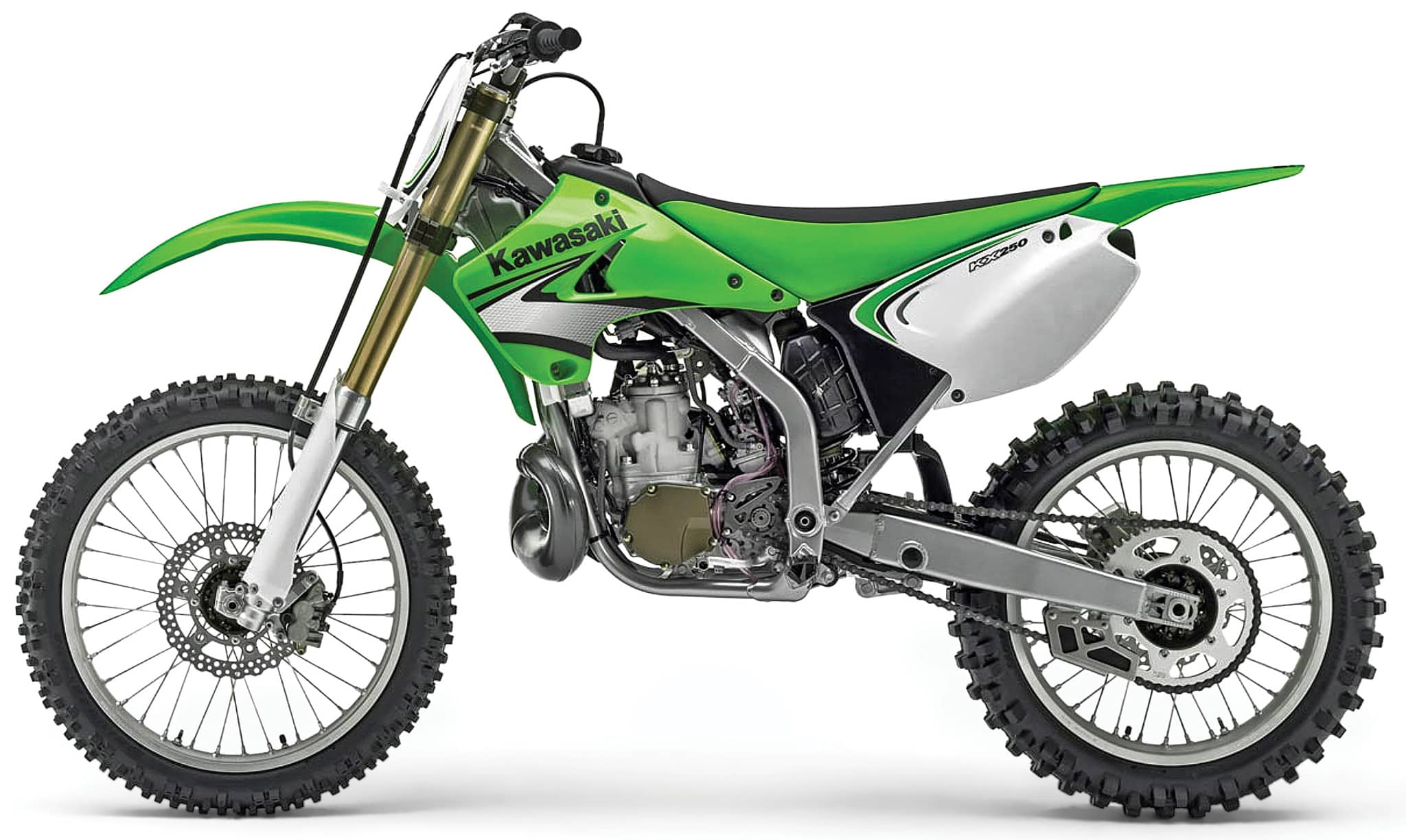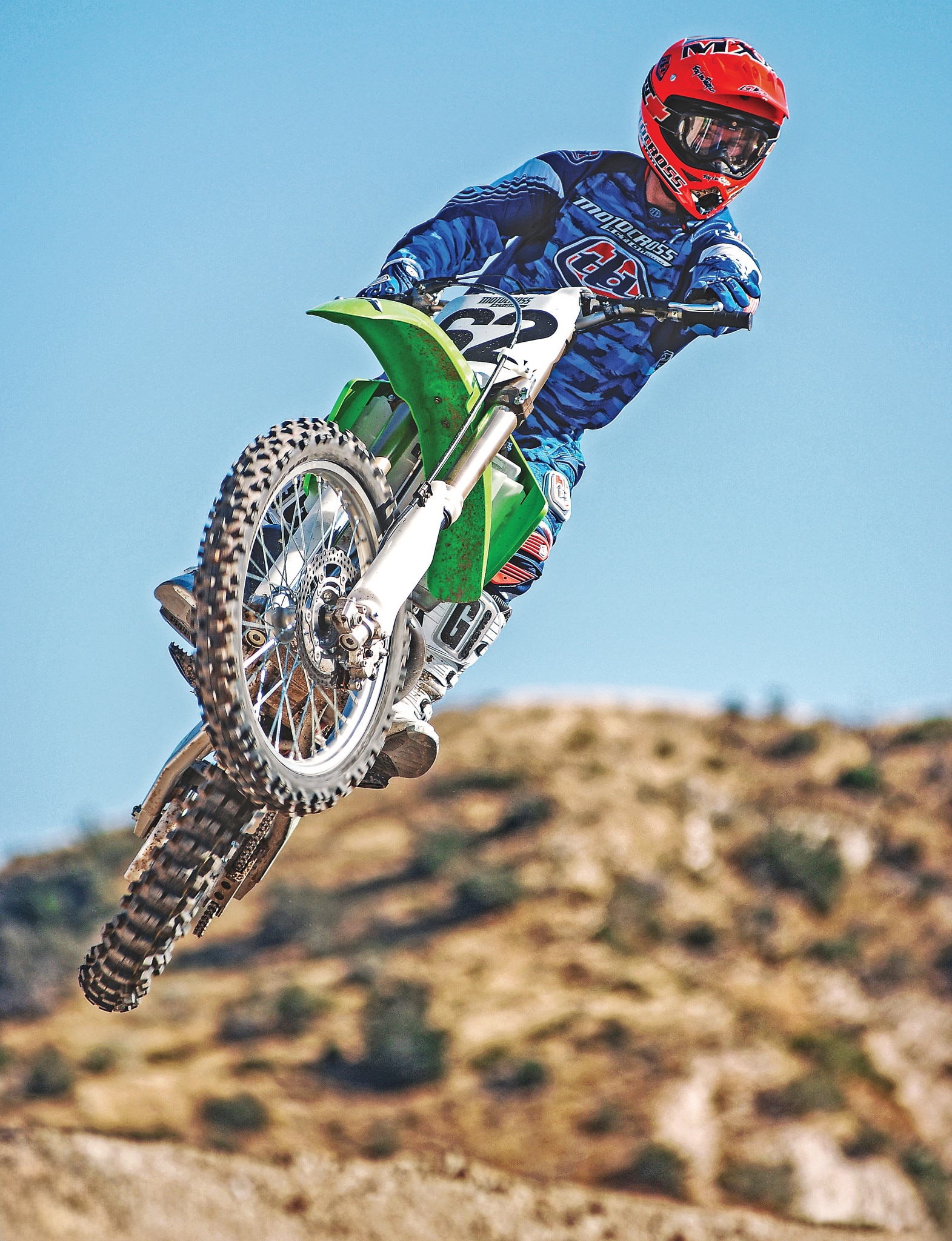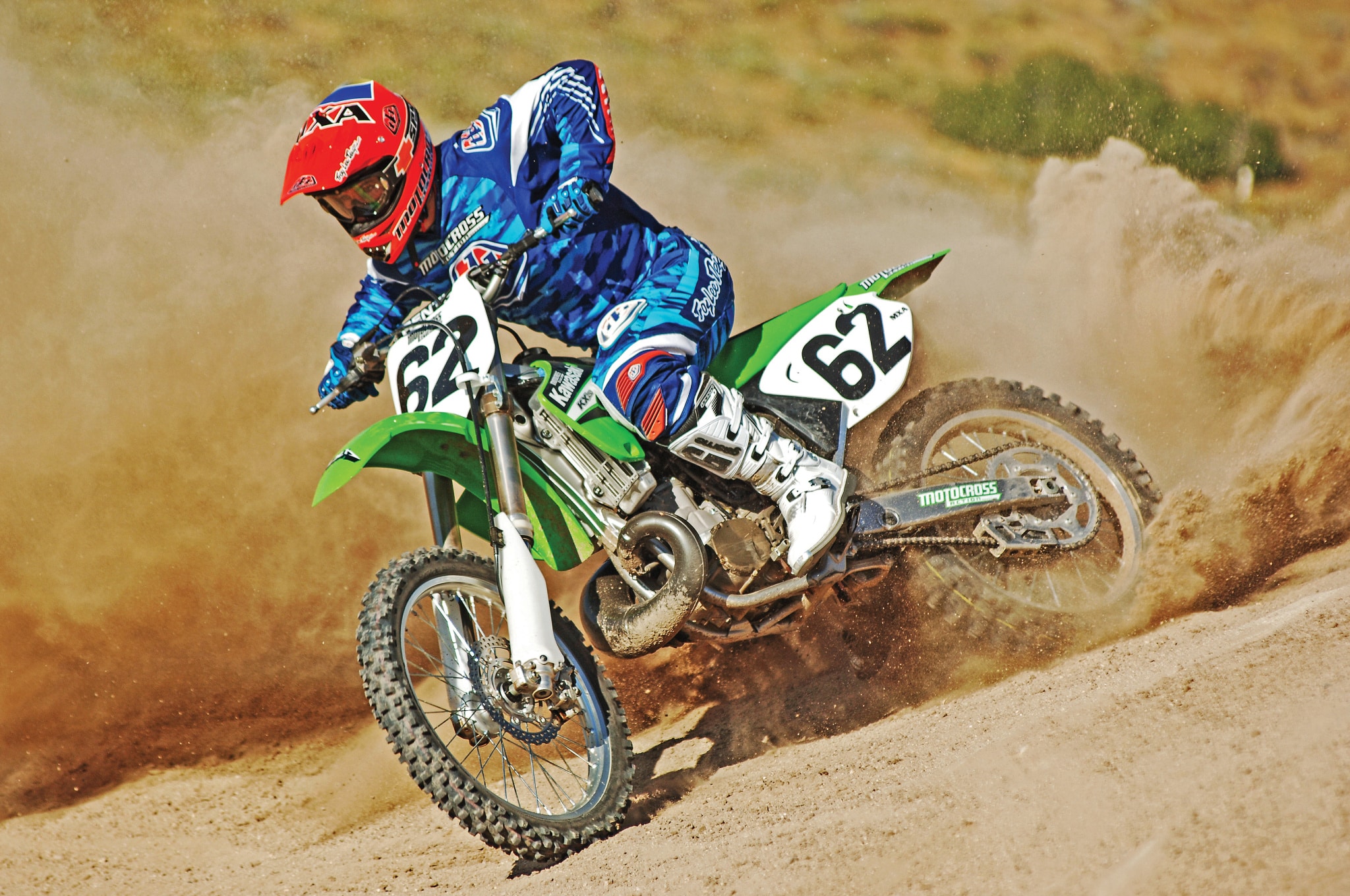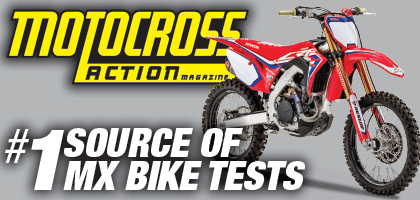MXA RETRO TEST: TESTING THE LAST KAWASAKI TWO-STROKE
 There is only one difference between a 2006 Kawasaki KX250 and the 2007 model and that is the graphics.
There is only one difference between a 2006 Kawasaki KX250 and the 2007 model and that is the graphics.
It is entirely possible that the 2007 Kawasaki KX250 is living on borrowed time. Last year, with little or no warning, Kawasaki dropped the KX125 from its lineup. The fact that the KX250 survived into 2007, albeit unchanged from 2006, is a testament to the hardcore loyalty of two-stroke fans. Kawasaki doesn’t want to abandon riders who are looking for a low-cost, easy-to-maintain, lightweight and snappy race machine. That list of attributes can only be applied to a two-stroke. By comparison, four-strokes are high-cost, hard-to-maintain, heavy and torquey race machines.
You don’t need to be Sherlock Holmes to know that the life span of the KX250 is limited. If there is a sudden resurgence of two-stroke buyers, it will survive. If not, it will go off life support.
As for now, the $5999 KX250 is still a vital part of Kawasaki’s business.
Q: DID KAWASAKI MAKE ANY CHANGES FROM THE 2006 TO 2007 KX250?
A: No. Just the normal BNG (bold new graphics) to the radiator graphics.

Q: IS THE 2007 KX250 ENGINE FASTER THAN LAST YEAR?
A: That would be an impossibility, because the 2007 KX250 engine is the 2006 KX250 engine.
THE KX250 PRODUCES A VERY OLD-SCHOOL STYLE OF POWER.
IT IS MORE LIKE THE MID-AND-UP ENGINES OF THE ’80S THAN
THE NEW BREED OF BROAD, TORQUEY TWO-STROKE POWERBANDS.
Q: IS IT FAST OR SLOW?
A: It is fast. Our test bike made 45.7 horsepower on the dyno. That’s right in the middle of the 250cc ballpark. The KX250 produces a very old-school style of power. It is more like the mid-and-up engines of the ’80s than the new breed of broad, torquey two-stroke powerbands.
Q: WHAT IS THE BEST THING ABOUT THE 2007 KX250 ENGINE?
A: Kawasaki’s gun-and-run powerband leaves no doubt about the rider’s responsibilities in motivating the green machine to move. It requires a full-throttle, pedal-to-the-metal, flat-out commitment to go fast on a KX250. This is a race-only engine. There isn’t a hint of trail bike sensibility to be found. You can’t tool around on the KX250 at half throttle, cruise through the turns or coast in the switchbacks. The KX250 is a pure gun-and-run engine.

Q: WHAT IS THE WORST THING ABOUT THE 2007 KX250 ENGINE?
A: The KX250’s brutal midrange hit and steady pull from mid and up come at the expense of rideability. It is not an easy bike to ride. It takes effort and energy to do things that the YZ250 and RM250 can do without breaking a sweat. Like what? The KX250 can’t sneak around an off-camber turn. It doesn’t have a smooth-enough transition from idle to the midrange to allow that. It doesn’t offer the rider the flexibility to slip through switchbacks at half throttle. When the KX250 comes on, it jolts the rear end loose. It lacks the light touch needed to tractor across rock-hard terrain; instead, it tries to smoke the knobs off with wheelspin.
Q: IS THERE A VALID HOP-UP STRATEGY FOR THE KX250?
A: Yes! The best hop-up strategy is to hop it down. The KX250 engine would benefit from having the combustion chamber volume increased and the compression ratio decreased. That would trade some of the hard hit for more controllable responses. It wouldn’t be as fast, but it would be more manageable.
Q: DOES THE KX250 HAVE THE BEST TWO-STROKE ENGINE IN THE SPORT?
A: Heavens to Murgatroyd, no! But, it does have a competitive engine that, in the right hands, can get the job done. We’d rate it below the Yamaha, Suzuki and KTM engines but ahead of the 2007 Honda CR250.
Q: WHAT ABOUT THE JETTING?
A: The jetting is lean. We replaced the 160 main with a bigger 162 and could have gone richer.
Here are the stock KX250 jetting specs (our changes are in parentheses):
Main jet: 160 (162)
Pilot jet: 50
Needle: NFTG
Clip: 2nd from top
Air screw: 1-1/2 turns out
THE KX250’S BRUTAL MIDRANGE HIT AND STEADY PULL FROM MID AND UP COME AT THE EXPENSE OF RIDEABILITY. IT IS NOT AN EASY BIKE TO RIDE. IT TAKES EFFORT AND ENERGY TO DO THINGS THAT THE YZ250 AND RM250 CAN DO WITHOUT BREAKING A SWEAT.
Q: WHAT ABOUT THE KX250 GEARING?
A: We don’t like the stock KX250 gearing and never have. There is a large gap between second and third gear. With the stock 51-tooth sprocket, the KX250 can fall off the pipe with every upshift unless you have it pegged. We added one tooth to the rear sprocket to lessen the gulf between second and third.
Q: WHAT ABOUT THE 2006 KX250 KAYABA FORKS?
A:The KX250’s Kayaba AOSS forks are not without flaws. In low-load situations, they ride fairly high in their stroke, but as soon as the load increases (like on the face of jumps, into G-outs or in big whoops), they drop down into their stroke and get very harsh. They feel stiff, but for some reason they still bottom. That’s a conundrum, because we think the spring rate is correct. These forks need to be re-valved.
Q: WHAT WAS OUR BEST FORK SETTING?
A: For hardcore racing, we recommend this fork setup:
Spring rate: 0.44 kg/mm
Oil height: 310cc
Compression: 12 clicks out
Rebound: 10 clicks out
Fork height: Slide the forks down as far as prudent in the triple clamps.
Q: WHAT ABOUT THE REAR SUSPENSION?
A: This is a very pogo-y bike. The rear drops in and rebounds out, and both movements are too quick for our tastes. Additionally, the KX250 sits too high in the rear. The result of the stinkbug rear end is that the head angle is steeper than optimal (and steeper than the offset of the triple clamps can handle). There is no bite from the front tire on the entrance of turns. It works okay in a straight line, but upsets the chassis whenever the rider tries to make directional changes over rough ground. The rear end overpowers the front.
Q: WHAT WAS OUR BEST SHOCK SETTING?
A: For hardcore racing, we recommend this shock setup:
Spring rate: 5.2 kg/mm
Race sag: 105mm
Hi-compression: 1-3/4 turns out
Lo-compression: 12 clicks
Rebound: 9 clicks
Notes: Although you might find clicker settings that will work for specific conditions, the basic problem with the KX250’s rear shock is with the rising rate and valving. Its dimensions and specs are off the chart.
Q: WHAT IS THE ULTIMATE FIX FOR THE REAR SUSPENSION?
A: Pro Circuit has a $185 shock linkage that changes the leverage ratio to hold the KX250 shock higher in its stroke longer. Conversely, stiffening the rising rate makes the KX250’s rear suspension feel softer. In action, it feels about one spring rate softer, which is a good thing. Pro Circuit couldn’t get away with this leverage ratio if they had to work with the shock seat height, which is already too high, but by lengthening the dog bone from 126mm to 129mm, the Pro Circuit link lowers the rear of the KX by 18mm.
Q: HOW DOES THE 2007 KX250 HANDLE?
A: Not a single MXA test rider liked the way the 2006 or 2007 KX250 handled. It “castered” on the entrance to turns. Why? Because Kawasaki steepened the head angle by a full degree on the 2006 and 2007 KX250 models, but they didn’t change the fork offset to feed trail back into the system. The result? No bite on the entrance of turns. Thankfully, the Pro Circuit linkage drops the rear of the KX250 enough to kick the head angle out approximately 1 degree, which in turn feeds some trail back into the front geometry.
In our opinion, this is an impaired chassis. The stinkbug rear end hampers not only the rear suspension but the handling as well.
Q: WHAT ARE THE MUST-HAVE AFTERMARKET PARTS FOR THE 2007 KX250?
A: Unfortunately, the KX250 wish list involves something you can’t buy—better handling. But, here are the things we would change.
Linkage: Without the Pro Circuit link, this bike is a handful.
Flywheel weights: Kawasaki offers several different versions. A little weight helps this bike a lot.
Front tire: A bike that turns this poorly needs the best rubber available.

Q: WHAT DID WE HATE?
A: The hate list:
(1) Shifting. Mediocre at best. Missed shifts are part of the package.
(2) Shift lever. It feels short and delivers almost no feedback. It is positioned too far inboard to ensure solid grip.
(3) Gearbox. The stock gearing is too tall (which aggravates the gap between second and third gear).
(4) Clutch. Grabby and vague.
(5) Tires. Kawasaki’s castering front wheel needs all the help it can get—and that doesn’t come from the Bridgestone 601 front tire.
(6) Handling. This is a “stomp and turn” chassis. What is that? When the KX250 turns, the front end steps out so fast that you have to stomp your boot on the ground to drag it back in.
Q: WHAT DID WE LIKE?
A: The like list:
(1) Power. We would have liked more half-throttle solutions to problems, but this is a fun powerband to use when you are fresh. It’s more of a Top Fuel dragster than a torquey motocross bike, but we are still thrilled by its ability to burn rubber.
(2) Handlebars. The aluminum Renthals are nice.
(3) Brakes. No complaints.
NOT A SINGLE MXA TEST RIDER LIKED THE WAY THE 2006 OR 2007 KX250 HANDLED. IT “CASTERED” ON THE ENTRANCE TO TURNS. WHY? BECAUSE KAWASAKI STEEPENEDTHE HEAD ANGLE BY A FULL DEGREE. ON THE 2006 AND 2007 KX250 MODELS.
Q: WHAT DO WE REALLY THINK?
A: This is a bike built solely for dedicated Kawasaki aficionados. It isn’t an everyman’s bike. It requires too much work to go fast on it, too much good fortune to get it around turns and too much anti-gravity matter to keep the rear suspension from pogoing.







Comments are closed.